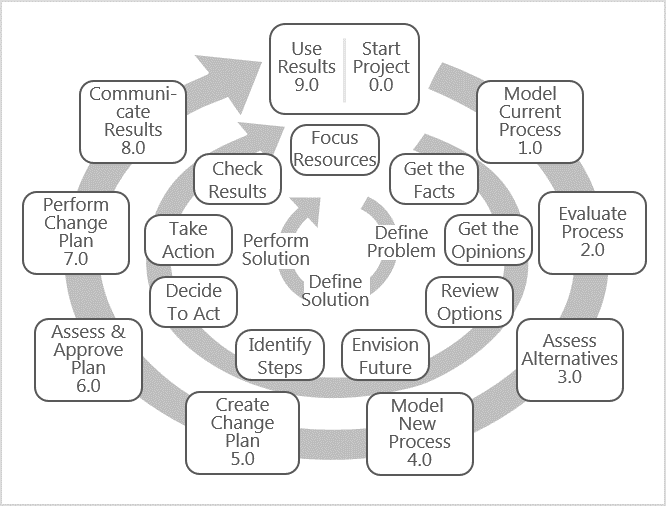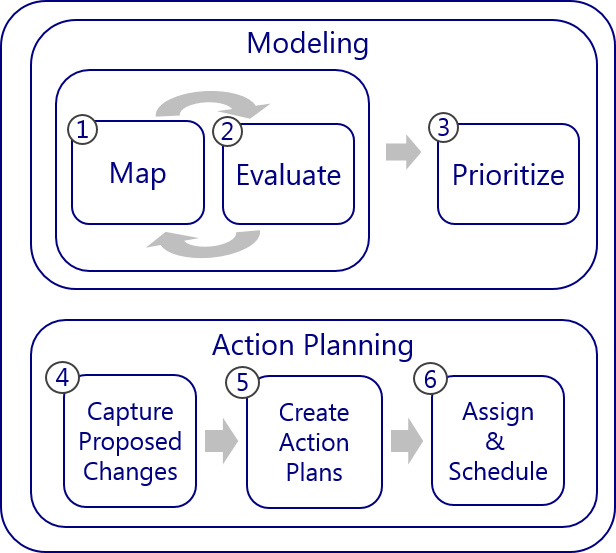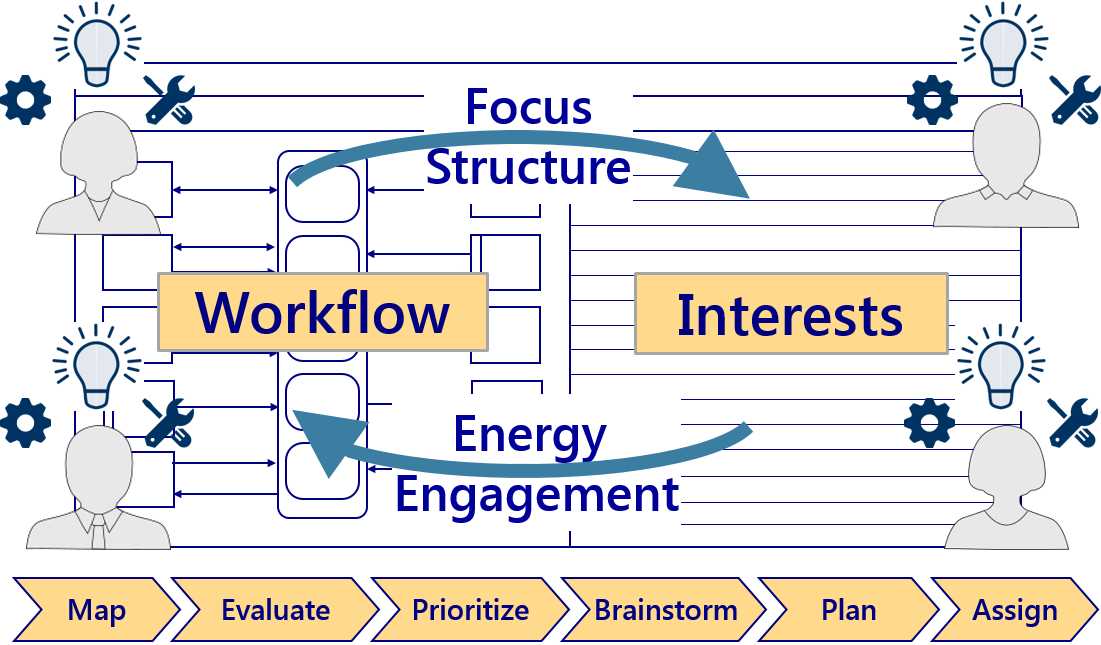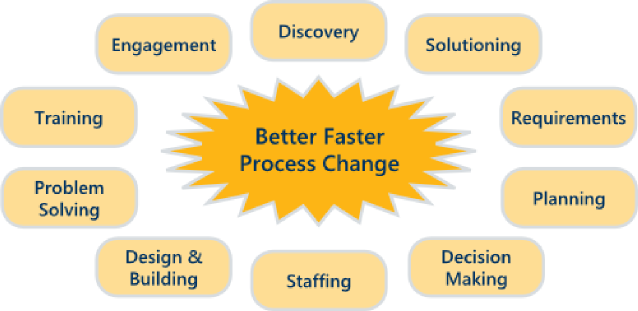Summary
We believe that process knowledge is the most valuable asset on the planet. That is because the value of all other assets depend on process knowledge, i.e. how to make use of the other assets.
ActionMap is a language for expressing, sharing and modifying process knowledge. We believe it works with people’s natural process thinking abilities. This page describes how we think that happens.
How does ActionMap have such a large scope of use?
The ActionMap Toolkit can be applied to virtually any activity that might be considered a process, and to any level or manner of change in that process (caveats: people need to be willing to participate and contribute, see this link). It is able to do this because the underlying method focuses on stakeholders’ process knowledge and process thinking capabilities in addition to focusing on the specific mechanics of the process area in question.
ActionMap’s thesis is that process knowledge, process change and process thinking operate according to mental behavior patterns that are fairly universal. The ActionMap method is optimized to support, strengthen and leverage those patterns.
This section provides a high-level overview of those patterns.
Please note:
=> This material does not need to be mastered or explained in order to effectively operate the ActionMap Toolkit software or to effectively participate in an ActionMap Toolkit meeting. The concepts are embedded in the method and automatically used in the ActionMap procedures and formats.
=> ActionMap methods evolved over the course of hundreds of flipchart and whiteboard-based meetings. The principles described below were arrived at through learning as much as intentional design.
=> While it might appear from the following description that ActionMap meetings are highly analytic and “dry”, our experience is that ActionMap meetings are highly energetic and engaging and can serve as strong team building events that provide ample opportunity for socialization. More on this at the end of this “secret sauce” section.
Free Form Conversation versus Systematic Construction
Consider a conventional meeting in which a process is being discussed (and note that this covers a large percentage of meetings.)
The primary near-term goal of such a meeting is to create strong shared understanding, agreement and commitment to take action, hopefully supported by compiled notes. If you could magically create those results without the meeting, you might not have the meeting, except for the socialization.
In such a meeting people are able to offer statements and questions about the process that can be essentially free form and in any pattern. A typical pattern is that a leading statement or question is offered. It is then followed by questions and counter-statements until a conclusion or impasse about the original leading statement or question is reached, or another leading statement or question takes over the discussion.
This conventional meeting pattern can be inefficient in terms of moving toward the goal of strong shared understanding, agreement and commitment to take action.
Our experience is that virtually all statements and questions that are made in such meeting can be categorized and organized according to the patterns described below. (This is from conducting hundreds of meetings using the ActionMap method on flipcharts; the same method as used in the software, applied to a different media.)
Based on that, the ActionMap method defines a specific procedural path for prompting for, capturing, organizing and re-displaying virtually all the information, interests, priorities and ideas that stakeholders are willing to express with respect to the activity being reviewed.
This path is optimized to produce the desired understanding, agreement and commitment to take action, along with detailed supporting documentation, as quickly and efficiently as possible.
To summarize, conventional meetings follow a free form path of exchanging knowledge, interests, priorities and ideas. That is inefficient and requires more and longer meetings to get to the desired results. ActionMap meetings use a highly structured process that moves directly toward the desired results, while at the same time supporting high levels of engagement and contribution.

Definitions
In this context “process” refers to any planned or repeated pattern of activity. This includes everything that would typically be thought of as an organizational, technological or natural world process.
=> Other definitions:
=> Business/TQM: a process is a set of activites designed to produce a specific result.
=> Physics: a process is an indefinitely extensible and indefinitely divisible set of events connected in cause and effect relationships within a conceptually bounded area of space and time.
=> ActionMap (internal): a process consists of a network of paths of movement, content that moves on those paths, assets that define the network and agents that along with assets provide the motive force.
“Process change” means any intentional, constructive change in process design and operations. This includes changes in workflow, stakeholders, staffing, training, materials, equipment and so on.
“Process knowledge” includes everything that stakeholders know and value about the process, including who the other stakeholders are and what they value.
Please note that process knowledge is different from what might be called “fact” knowledge. For example, you could probably quickly name five facts about your shoes. However, it might take longer to describe how to tie a pair of shoe laces.
There are two insights here:
1) Process knowledge is largely sub-conscious. That is, people are able to readily perform processes, however, they are often not immediately conscious of how they perform those processes (e.g. tying a pair of show laces.)
Because of this, process knowledge often needs to be prompted for and brought to conscious awareness in order for it to be used in process change.
2) Once process knowledge is learned it is to easy apply. However, process knowledge can require considerably more time and effort to acquire, master, express, share and distribute.
“Process thinking” means the creation, manipulation and expression of mental models of processes.
As such, process knowledge and process thinking are intimately connected.
Major Patterns in Process Knowledge and Process Thinking
Conceptual Categories
Process knowledge and process thinking are organized and operate through the use of mental concepts. These concepts are organized in categories. These categories are used by essentially all people (after a certain age) to organize what they know and experience about processes.
Again, our thesis is that these conceptual categories are used unconsciously and subconsciously by virtually everyone all the time. ActionMap provides an external structure that makes use of these conceptual categories without requiring explicit description of them.
The result is a method that is highly intuitive and easy to understand (because it is based on the way people unconsciously organize information) while at the same time being highly efficient and effective at sharing process knowledge (for the same reason).
Conceptual categories can be described using pairs of opposites. Specific things can be located either at one end of these pairs or somewhere in between.
Here is a list of such categories:
Current State <=> Future State
Steady State <=> Changing State
Operations <=> Planning
Operations <=> Management
Operations <=> Support
Objective <=> Subjective
Controllable <=> Uncontrollable
Inside <=> Outside
Contained <=> Containing
Interacts With <=> Does Not Interact With
Goes From <=> Goes To
Sends <=> Receives
Flow of Stuff <=> Flow of Control
Input <=> Process <=> Output
Caused Causes <=> Caused By
Changes Location <=> Stays in One Place
Changes Shape <=> Stays the Same Shape
Changes Composition <=> Stays the Same Composition
Changes Shape <=> Changes Location
Changes Shape <=> Changes Composition
Divisible <=> Indivisable
Permanent <=> Transient
Caused <=> Cause-less
Associated With <=> Not Associated With
Desirable <=> Undesirable
Important <=> Not Important
Confirmed <=> Conjectured
Possible <=> Not Possible
Shared <=> Not Shared
Recorded <=> Not Recorded
Visually Illustrated <=> Not Visually Illustrated
Understood <=> Not Understood
Agreed to <=> Not Agreed To
Committed To <=> Not Committed To
Personality Type Functions
The above categories are mentally processed by high-level functions that are again universal (following from Carl Jung and Myers-Briggs):
Sensation => facts, data, details, specifics
Feeling => likes/dislikes, emotions, values, performance states
Thinking => common sense cause and effect logic, sequential story telling
Intuition => patterns, probabilities, insights
Problem Solving / Improvement Cycles
People regularly use what we believe to be a universal problem solving/improvement cycle that is related to the above patterns. The cycle takes many forms in many different methodologies. This Improvement Cycle is expressed in ActionMap in the following illustration.
The ActionMap Improvement Cycle

In an ActionMap meeting the Improvement Cycle is condensed to the Main Cycle (described in the Overview page). If needed the Main Cycle can be repeated to cover all the different phases in the Improvement Cycle.

The Improvement Cycle and Main Cycle are used flexibly. Important collaboration results are often achieved with just the Modeling stages and even with just the Map and Evaluate stages. With that knowledge in hand people can and will continue the Improvement Cycle informally or in other methods.
Learning Patterns – Analysis and Synthesis
People follow common learning patterns of:
=> starting with generalities and working down into detail, and
=> adding those details back up to a new understanding.
This leads to using the Improvement Cycle, the stages within the Improvement Cycle and the techniques within the Improvement Cycle in repeated sub-cycles, starting with high level views and working down into specifics, and then adding the specifics back up into complete designs and plans.
=> Please note that while most of the above concepts and patterns are only incidentally mentioned in descriptions of the ActionMap method, they are all specifically used at detailed points in the formats and procedures.
Use of these Patterns in ActionMap
Repeating the above, in a conventional meeting that relies on un-illustrated, un-recorded and un-structured verbal communication, participants can combine several of the above categories, functions and phases in single statements or questions that can be offered in any sequence.
In an ActionMap meeting participants can express everything that they would normally express in free form discussion. However, in an ActionMap meeting contributions are prompted for, captured and organized using formats and procedures that support, strengthen and leverage the subconscious use of these natural, universal categories, functions and phases.
=> Please note that while these design concepts are only incidentally mentioned in descriptions of the ActionMap method, they are specifically used at detailed points in the formats and procedures.
Because of this process knowledge, that is, mental models of the process in question, can be communicated, assembled, manipulated, developed and improved upon much more quickly, accurately and completely than in a conventional meeting.
The ActionMap method specifically aims its procedures and formats at constructing the key results of collaboration in process change, i.e. understanding, agreement and commitment to take action supported by high quality models, evaluations and action plans.


The net result again is fewer meetings and earlier realization of process change benefits.
Engagement and Socialization
Repeating the above, while it might appear that ActionMap meetings are analytic and “dry”, our experience is that ActionMap meetings are highly energetic and engaging and can serve as strong team building events that provide ample opportunity for socialization.
We believe that there are several factor at play here:
People want other people to understand their work => the process modeling supports this.
People want other people to understand their values, interests, concerns and ideas => the evaluations and brainstorming support this.
People want to understand other people’s work and values => the entire ActionMap method supports this.
People want to make progress. Studies show that a large part of engagement comes from a sense of making progress. ActionMap meetings produce a strong sense of making progress.
The most effective team building occurs when people work together to produce real value. ActionMap meetings are real work that produce real value from people working together.
Accelerate Innovation

